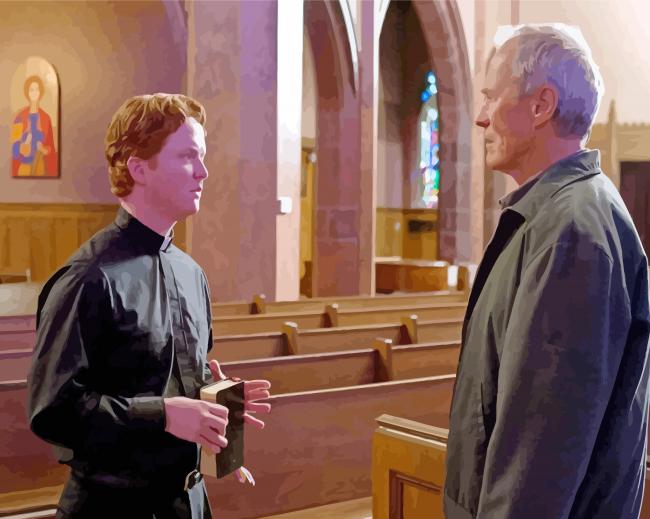Gran Torino characters have become legendary in the world of cinema. The film, directed by Clint Eastwood, is more than just a story about a car or a grumpy old man. It’s a powerful narrative that explores themes of redemption, racism, and human connection. If you’re a fan of this movie, you’re in the right place. We’ll be diving deep into the personalities, backstories, and significance of each character, so buckle up!
When Gran Torino hit theaters in 2008, it wasn’t just another movie about cars and guns. This film struck a chord with audiences because of its raw and authentic portrayal of complex characters. From Walt Kowalski’s journey of self-discovery to the Hmong community’s struggle for acceptance, every character plays a crucial role in shaping the story. So, why not take a closer look at what makes these characters so unforgettable?
This article isn’t just a character breakdown; it’s an exploration of how Gran Torino characters reflect real-life issues like prejudice, family dynamics, and personal growth. Whether you’re revisiting the movie or learning about it for the first time, this deep dive will give you a fresh perspective on the people who made Gran Torino a timeless classic. Let’s get started!
Read also:Caroline Kennedyrsquos Journey With Rheumatoid Arthritis A Story Of Strength And Resilience
Table of Contents
- Main Character: Walt Kowalski
- Supporting Characters in Gran Torino
- Who Is Walt Kowalski?
- Thao Vang Lor: The Reluctant Teenager
- Sue Vang Lor: The Heart of the Family
- Frank: Walt’s Estranged Son
- Themes Through Gran Torino Characters
- The Impact of Gran Torino Characters
- Character Analysis and Symbolism
- Conclusion: Why Gran Torino Characters Matter
Main Character: Walt Kowalski
Let’s kick things off with the guy who steals the show—Walt Kowalski. Played by none other than Clint Eastwood himself, Walt is the heart and soul of Gran Torino. At first glance, he’s just a grumpy old man who doesn’t suffer fools gladly, but as the story unfolds, we see layers of complexity that make him one of the most compelling characters in modern cinema.
Walt’s journey is one of transformation. He starts off as a bitter widower who’s stuck in his ways, clinging to outdated ideas about race and community. But through his interactions with the Hmong family next door, he learns to let go of his prejudices and embrace a new kind of family. It’s not just about redemption—it’s about finding purpose in life again.
Who Is Walt Kowalski?
Walt Kowalski is a retired Ford assembly line worker living in Detroit. He’s a Korean War veteran who’s seen his fair share of bloodshed and loss. His wife has passed away, leaving him alone in a house filled with memories. Walt’s prized possession is his 1972 Gran Torino, a car that represents his connection to the past and his sense of identity.
But Walt isn’t just defined by his car. He’s a man who’s deeply affected by the world around him. His interactions with the Hmong community, particularly Thao and Sue, force him to confront his own biases and ultimately lead to a profound change in his outlook on life. By the end of the movie, Walt becomes a symbol of hope and sacrifice, proving that even the hardest hearts can soften.
Supporting Characters in Gran Torino
While Walt Kowalski is the star of the show, the supporting characters in Gran Torino are just as important. Each one brings something unique to the table, enriching the story with their own struggles and triumphs. Let’s take a look at some of the key players:
- Thao Vang Lor: The reluctant teenager who becomes Walt’s protégé.
- Sue Vang Lor: Thao’s sister and the glue that holds the family together.
- Frank: Walt’s estranged son, representing the strained relationship between father and child.
- Father Janovich: The local priest who tries to bridge the gap between Walt and the Hmong community.
Thao Vang Lor: The Reluctant Teenager
Thao Vang Lor is a pivotal character in Gran Torino. At the beginning of the movie, he’s a shy and awkward teenager who gets pressured into joining a gang. But when Walt steps in to protect him, Thao’s life takes a dramatic turn. Under Walt’s guidance, he learns valuable lessons about responsibility, courage, and respect.
Read also:Raymond Patriarca Jr Daughter Unveiling The Legacy And Life
Thao’s transformation is one of the most rewarding arcs in the film. From a scared kid trying to prove himself to a young man with a sense of purpose, his growth mirrors Walt’s own journey. It’s a testament to the power of mentorship and the impact one person can have on another’s life.
Sue Vang Lor: The Heart of the Family
While Thao gets most of the attention, Sue Vang Lor is the unsung hero of the Hmong family. As the eldest daughter, she shoulders the responsibility of caring for her younger siblings and keeping the family together. Sue’s strength and resilience are a constant presence throughout the movie, and her relationship with Walt evolves from distrust to genuine friendship.
Sue represents the bridge between two worlds—the Hmong community and Walt’s predominantly white neighborhood. Her ability to navigate these cultural differences is crucial in breaking down barriers and fostering understanding. She’s a reminder that even in the face of adversity, family and community can provide the support we need to thrive.
Frank: Walt’s Estranged Son
Frank, Walt’s son, is a complex character who embodies the tension between generations. He’s a successful lawyer who’s more concerned with appearances than substance. His strained relationship with Walt highlights the disconnect between fathers and sons, a theme that runs throughout the movie.
Frank’s presence in the story serves as a foil to Walt’s evolving character. While Walt learns to let go of his prejudices and embrace change, Frank remains stuck in his own bubble of privilege and entitlement. It’s a stark contrast that underscores the importance of personal growth and adaptability.
Themes Through Gran Torino Characters
Gran Torino is more than just a character-driven story—it’s a exploration of universal themes. Through its characters, the movie tackles issues like racism, family, and redemption. Let’s break down some of the key themes:
- Racism: Walt’s initial prejudice against the Hmong family is a reflection of deeper societal issues. His journey toward acceptance is a powerful statement about the need for empathy and understanding.
- Family: Whether it’s Walt’s strained relationship with his sons or the tight-knit bond of the Hmong family, the movie emphasizes the importance of family in shaping our lives.
- Redemption: Walt’s transformation from a bitter old man to a selfless hero is a testament to the possibility of change, no matter how entrenched our beliefs may be.
The Impact of Gran Torino Characters
The characters in Gran Torino have left a lasting impression on audiences worldwide. Their authenticity and depth have made them relatable and memorable. But what makes these characters so impactful? It’s their ability to reflect real-life struggles and triumphs.
Walt Kowalski’s journey of self-discovery resonates with anyone who’s ever felt stuck in their ways. Thao’s transformation from a scared kid to a confident young man speaks to the power of mentorship. Sue’s strength and resilience remind us of the importance of family and community. And Frank’s entitlement serves as a cautionary tale about the dangers of privilege.
Character Analysis and Symbolism
Every character in Gran Torino is rich with symbolism and meaning. Let’s take a closer look at how these characters contribute to the overall message of the movie:
- Walt’s Car: The 1972 Gran Torino isn’t just a car—it’s a symbol of Walt’s identity and his connection to the past. When he ultimately sacrifices it for Thao, it represents his willingness to let go and embrace change.
- Thao’s Transformation: Thao’s journey from a scared kid to a confident young man mirrors Walt’s own transformation. It’s a reminder that growth is possible, even in the most unlikely circumstances.
- Sue’s Strength: Sue’s ability to navigate cultural differences and bring people together is a testament to the power of empathy and understanding. She’s a symbol of hope and resilience.
These symbolic elements elevate the characters beyond their individual stories, making them part of a larger narrative about humanity and connection.
Conclusion: Why Gran Torino Characters Matter
In conclusion, the characters of Gran Torino are more than just figures on a screen—they’re representations of real-life struggles and triumphs. From Walt’s journey of redemption to Thao’s transformation and Sue’s strength, each character adds depth and meaning to the story.
If you’ve enjoyed this deep dive into Gran Torino characters, why not share your thoughts in the comments below? Or better yet, revisit the movie and see if you notice anything new about these incredible characters. Remember, the power of cinema lies in its ability to connect us to stories that reflect our own lives. And Gran Torino does just that.
So, what are you waiting for? Dive into the world of Gran Torino and discover the magic of its characters for yourself. And don’t forget to check out our other articles for more insights into the world of cinema!

